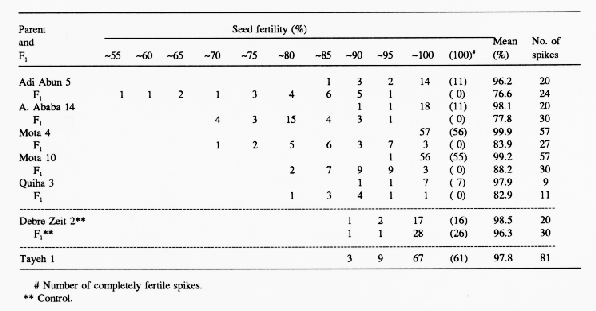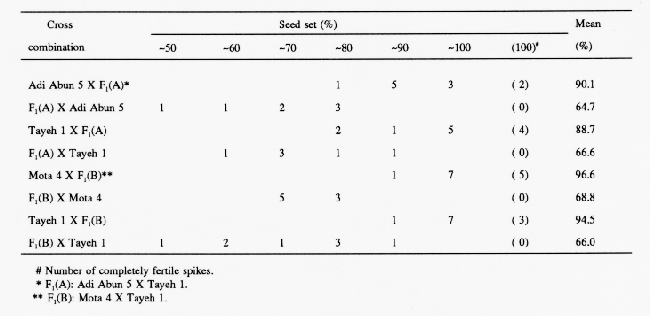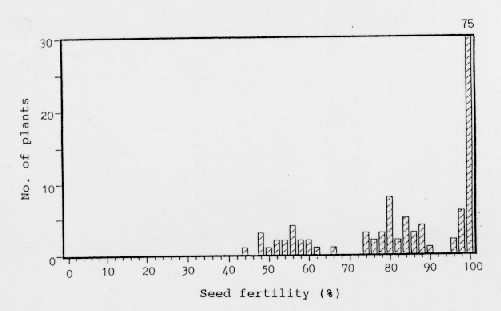

In barley (Hordeum vulgare L.) and H. spontaneum C. Koch, chromosome configurations at meiosis of hybrids within and between the species are normal, and the resulting hybrids are highly fertile in general. However, Konishi and Linde-Laursen (1988) demonstrated that F1 plants between 51 of 139 Ethiopian lines and Tayeh 1, a Chinese landrace, were partially sterile. Among them, partial sterility in four hybrids was caused by spontaneously reciprocal translocations of Ethiopian parents, whereas the other 47 hybrids showed normal chromosome configurations at meiosis. From these results, we assumed the hybrid sterility was controlled by genic interactions and conducted genetic analysis of the hybrid sterility.
For examining the hybrid sterility, five lines which were randomly chosen from the 47 Ethiopian lines were crossed with Tayeh 1. Seed fertility per spike of the F1 plants and their parents was determined by dividing the number of fertile seeds by that of spikelets in the central rows. Seed fertility of the F1 plants was shown in Table 1. All spikes of the F1 plants were partially sterile, while those of the parents were highly fertile. Seed fertility of the hybrids ranged from 46.7 to 95.5%, the average was 81.9%.
For identifying the model of inheritance for the hybrid sterility, seed fertility of each three spikes per plant was examined in F2 populations derived from the five cross combinations, and segregation of the F2 individuals for seed fertility was tested. As shown in Fig. 1, seed fertility ranged from 38.0 to 100%, and F2 individuals were classified into three groups by seed fertility. They were semi-sterile (less than 70%), partially sterile (70 to 90%), and fertile (more than 90%) groups. Segregation ratio of F2 individuals in these groups was 18 (semi-sterile): 31 (partially sterile): 84 (fertile). Similar segregation was observed in the other F2 populations.
Pollen of the F1 hybrids and their parents were stained with iodine-potassium-iodine solution and observed. Almost all the pollen was well-stained, indicating that hybrid sterility was not caused by pollen abnormality. When the F1 plants were used as the female in backcrosses, seed set was lower, around 25%, than when they were used as the male (Table 2).
These results suggest that the hybrid sterility is controlled by duplicate genes for gametic lethality, and that the genes affect only female gametes.
Reference:
Konishi, T., and I. Linde-Laursen. 1988. Spontaneous chromosomal rearrangements in cultivated and wild barleys. Theor. Appl. Genet. 75:237-243.


